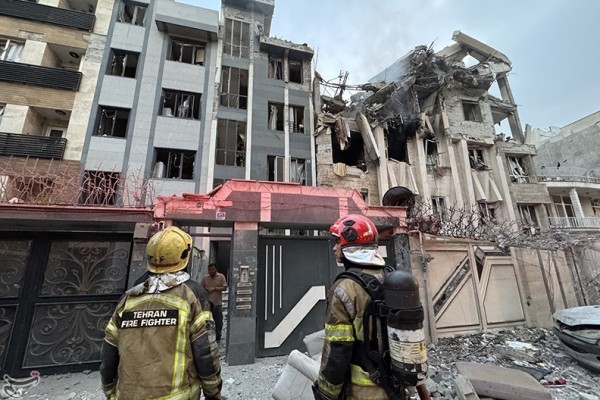Trump’s ‘maximum pressure’ Iran strategy in historical perspective

Anti-American propaganda artwork on a wall just outside of the former American embassy in Tehran.
In January, the Doomsday Clock—a symbol of how close we are to “destroying our world” using “dangerous technologies of our own making”—was advanced to its most dire setting since it was created by the Bulletin of Atomic Scientists in 1947. Among the reasons given was “the US withdrawal from … the Iran Nuclear Deal,” an instance of “our mechanisms for collaboration … being undermined when we need them most,” said former UN Secretary-General Ban Ki-moon.
Toward the end of the second term of US President Barak Obama, in 2015, Iran entered the Joint Comprehensive Plan of Action (JCPOA) with the permanent members of the UN Security Council—the United States, Britain, France, Russia and China—plus Germany and the European Union to receive sanctions relief in exchange for assurances that it would limit its nuclear development program to peaceful purposes.
In May 2018, Donald Trump’s administration unilaterally withdrew from the deal and reinstated sanctions. In November 2018, the administration issued waivers that allowed some countries to buy oil from Iran on the condition that the proceeds from sales be restricted to the purchase of humanitarian goods, but half a year later the waiver program ended, both deepening the devastation in the Iranian economy, and increasing suffering by making it more difficult for the regime to purchase food and medicine for its citizens. At the same time, the US significantly boosted its military presence in the Persian Gulf region, and designated Iran’s Islamic Revolutionary Guards Corps (IRGC) a foreign terrorist organisation, making it difficult for the IRGC to do business. The IRGC is both a powerful military force alongside Iran’s regular military, and the leading economic and political power in the country, consisting of approximately 190,000 members, closely tied to the Supreme Leader, and including the Quds force, Iran’s elite commando and espionage unit.
Finally, in the background, some US military officials say quietly that the new tactical nuclear weapon being used to arm US Trident ballistic submarines since about January 2019 was designed for scenarios like war with Iran. Thus, the Trump administration has been tightening the screws in its strategy of “maximum pressure” on Iran.
The likely goal of the about-face on the nuclear deal and the ramped up pressure is regime change in Iran. The immediate result has been to shred the already tenuous peace between Washington and Tehran. From the summer of 2019 onward, hostilities have flared up repeatedly.
On January 2, 2020, Trump ordered a drone strike that assassinated Iranian Major General Qassim Suleimani while he was in Iraq. Reputedly the second most powerful member of the Iranian regime, Suleimani was the revered commander of the Quds force and the architect of Iran’s regional security. Iran quickly announced its withdrawal from the nuclear deal, and on January 8 retaliated with missile attacks on US bases in Iraq. While not hit directly, at least 64 American troops suffered traumatic brain injuries with various levels of severity due to blast proximity, although Trump discounted the injuries as “headaches.”
Amidst the open hostility, 176 civilians, including 57 Canadians, were killed when Iran shot down Ukraine Airlines Flight 752 near Tehran, reportedly by accident, after which the escalating conflict paused.
Hostilities will resume, likely in Iraq, Syria, and elsewhere, continuing something of a dangerous cold war scenario between the US and Iran in the volatile and petroleum-rich Middle East. The prize is regional influence, either for Iran, or for the US and its important allies in the region—especially Israel and Saudi Arabia.
Regime change in Iran has been on the US radar since 1979 when the Islamic Revolution replaced the Iranian monarchy which had worked closely with America for 25 years. There are excellent reasons for change in Iran—reasons that prompt dreams of regime change—but there is almost no likelihood of successful regime change in Iran instigated by America and its allies. The current Iranian leadership is a continuation of the regime that seized power in 1979 which has been confronted with everything from internal protest and external pressure to all-out war. The regime is as unlikely to be changed into a stable government amenable to the US and its allies as have been the governments of Afghanistan, Iraq, Libya, Syria and Venezuela, where regime change has miscarried, leading to widespread death, suffering, destruction, instability, and forced migration crises.
Ideological blinders have repeatedly convinced us that intervention would be met with open hearts and minds, promising short-to-medium term success, but we have failed to recognise that the Taliban in Afghanistan, Saddam in Iraq, Gaddafi in Libya, Assad in Syria, and Maduro in Venezuela maintained, or have maintained, themselves by more than mere power.
Even brutal regimes have significant allies and stakeholders that benefit from the status quo, many residents who prefer adaptation rather than revolutionary struggle, and many who are wary of foreign intervention. The result is regime inertia, and, in some cases, significant regime support. Additionally, because intervention is violent and messy, it necessarily accumulates harmful mistakes and side-effects, which are inevitably framed ideologically, only to alienate hearts and minds. Finally, if a regime is toppled, the resulting instability drains success into the pit of endless insurgency and misery.
Mohammad Mosaddegh
In June 2009, Obama publically acknowledged: “the United States played a role in the overthrow of a democratically elected Iranian government” in 1953. In March 2000, US President Bill Clinton’s Secretary of State Madeleine Albright publically acknowledged: “In 1953 the United States played a significant role in orchestrating the overthrow of Iran’s popular Prime Minister, Mohammed Mossadegh.” “[T]he coup was clearly a setback for Iran’s political development. And it is easy to see now why many Iranians continue to resent this intervention by America in their internal affairs.” The US installed Iran’s monarch—the Shah—to replace Mossadegh, and “during the next quarter century, the United States and the West gave sustained backing to the Shah’s regime” which “brutally repressed political dissent.” Unfortunately, today, as many Iranians find reassurance in these acknowledgements as Americans and US allies remember why they were made. Whereas social memory provides Iranians with reasons to mistrust US-led intervention, collective amnesia allows America and its allies to imagine that the liberation of Iran is something that can be accomplished.
The 1953 coup can be traced back to 1914, when the British government purchased 51 percent of what would become the Anglo-Iranian Oil Company (later BP), which arose out of the British interests that first developed oil production in Iran. Following the two World Wars, the company was generating massive revenues for Britain, greatly exceeding benefits for Iran. In 1951, a country-wide movement supported Mossadegh’s nationalisation of the oil industry. Loath to concede anything, Britain and Anglo-Iranian Oil fought back with dirty tricks, threats of aggression, and an embargo that devastated Iran’s economy.
According to subsequently released confidential American documents, in April, 1951 US Assistant Secretary of State George McGhee urged the British to offer Iran “a ‘flavor’ of nationalization … that would have minimum effect upon the actual control of the company’s operations.” As US Secretary of State Dean Acheson indicated, America “recognizes” the “right of sovereign states to nationalize” as long as that right is “not publicised abroad” where “it might encourage … states to nationalize.” In fact, the “US does not favour nationalization.” America did not favour Iran exercising its rights—at least not beyond a mere “flavour” of them—if doing so would diminish American interests or the interests of its allies. A contemporary US State Department document indicated America’s “own great interests in Iran.” “We should like to emphasise the vital necessity of full cooperation in future actions … by the US and UK Governments and their respective oil interests.” Access to Iran’s world-class oil resources trumped Iran’s recognised right to nationalize them.
Britain’s hard-line led to the October 1952 expulsion of its diplomats, making it impossible to pursue oil interests from within Iran.
The US stepped up. Subsequently released documents from the CIA’s plan to remove Mossadegh—“Operation AJAX”—reveal the leading US role in staged attacks on religious leaders to turn them against Mossadegh, in the publication of fake news connecting Mossadegh to communism, in the bribery of legislators, and in the mobilisation of violent street gangs. With the involvement of selected Iranian military leaders, Mossadegh was ousted in August, 1953, and replaced by the Shah.
Massive protests broke out across Iran in August 1953, precipitating the overthrow of Mohammad Mossadegh in a coup orchestrated by the CIA and British intelligence. The Shah was reinstalled as Iran’s leader.
Thus, the most popular elected leader modern Iran has ever known was illegally deposed by a coup led by the US, and replaced by a US-backed monarch who became the oppressive leader of a US-compliant Iran until the 1979 Islamic revolution.
The disputed oil concession was taken over by a consortium of eight companies, including Anglo-Iranian and five American companies.
For many Iranians, the 1953 intervention constituted a deeply damaging violation of sovereignty and democracy, not to mention extensive neocolonial exploitation. During the weeks leading up to the Islamic revolution, US President Jimmy Carter’s administration tried to negotiate with the revolution’s leader, Ayatollah Ruhollah Musavi Khomeini. Khomeini was concerned that the US would attempt in 1979 what it had accomplished in 1953. However, he soon understood that America was more interested in assurances about preserving its interests if the Shah were removed. Khomeini saw an open path, offered vague assurances about US interests, and made his move. He became the first Supreme Leader of Iran, only to pursue Iran’s new interests exclusively. As the revolution unfolded, 52 American embassy officials were taken hostage and held for 444 days, in part as insurance against a replay of 1953. Khomeini famously said “America can’t do a damn thing.” He had outmaneuvered the US.
During the post-revolutionary period, the monarchy was replaced with an Islamic Republic—a state with limited republican structures but fundamentally ruled by the Supreme Leader and the IRGC, itself developed to defend the new Islamic system. Power was brutally consolidated, leading many Iranians to flee the country. At the time, Ayatollah Ali Hosseini Khamenei, who would become the second, and current, Supreme Leader, said “we are not liberals like … Mossadegh, whom the CIA can snuff out.”
If in 1953 a very popular and capable secular nationalist leader was unable to defend Iran’s independence against the US, from 1979 onward a leadership grounded both in religious and cultural custom, and in harsh military order would prevail.
Under the long shadow of the aggression of 1953, more than a few Iranians will blame the American strategy of maximum pressure for the economic, humanitarian, and military crises they are facing. They have good reasons to tolerate their regime more than one the US and its allies would install, again.
If it is argued that 1953 is ancient history, or that the US and its allies have changed, the recent failures in Afghanistan, Iraq, Libya, Syria, and Venezuela should teach us all that regime change is a reckless strategy that is almost certainly doomed to fail.
For some, the goal of the ramped up intervention is regime collapse—that is, the degradation and destabilization of the Iranian regime. ‘Benefits’ would include greater influence for the US and its allies in the region. The costs, on the other hand, would include years of death, suffering, forced migration, destruction, and greater destabilization throughout the Middle East.
At 100 seconds before midnight, let us hope not all the Angels have abandoned us.
John Duncan is director of the Ethics, Society and Law program at Trinity College, and academic director of the Ideas for the World program at Victoria College, in the University of Toronto. Follow him on Twitter @John__Duncan.










